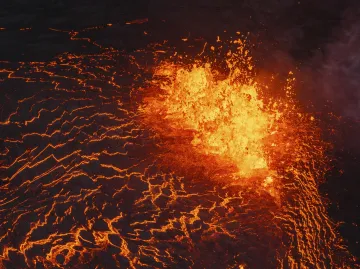A volcano in Iceland spewed smoke and lava for a second day on Thursday but winds were expected to carry poisonous gas pollution away from the capital Reykjavik, authorities said.
The eruption, the fifth since December, was the most powerful in the area since volcanic systems on the Reykjanes peninsula became active three years ago after lying dormant for eight centuries, according to the Icelandic Met Office.
The town of Grindavik, where only a few people have returned after several homes were destroyed by lava earlier this year, was again subject to an evacuation order, as was the nearby Blue Lagoon outdoor spa, a major tourist attraction. Volcanic activity decreased late on Wednesday but remained steady through the night, the Civil Protection agency said in a statement.
There were no reports of injuries.
"Westerly winds are expected today, and gas pollution may then spread to the east over southern Iceland," the agency said. Sensors showed air quality remained "very good" in and around the capital while a station closer to the eruption indicated it was "unhealthy for the sensitive".
Lava on Wednesday flowed over the main road that runs towards Grindavik, and images in local media on Thursday showed it was partly covered by a large mass of dried black rock. Lava flows also reached the dykes built around Grindavik, diverting the molten rock west around the town according to the met office. Keflavik airport, Iceland's biggest, was operating as usual.
Workers and anyone still in town were ordered to leave earlier in the day, police said. The Blue Lagoon thermal spa — one of Iceland's biggest tourist attractions — was evacuated before the eruption began, RUV said.
At one point, a dark plume of ash boiled up over the crater from an explosive interaction of magma hitting groundwater, scientists said. The cloud did not rise high enough to initially pose any threat to aviation, but scientists were closely monitoring the situation, Jóhanna Malen Skúladóttir, of the Met Office, told RUV.
Grindavik, which is about 50 kilometres southwest of Iceland’s capital, Reykjavik, has been threatened since a swarm of earthquakes in November forced an evacuation in advance of the initial December 18 eruption. A subsequent eruption overwhelmed some defensive walls and consumed several buildings. The area is part of the Svartsengi volcanic system that was dormant for nearly 800 years before reawakening.
The volcano erupted again in February and March. The Feb. 8 eruption engulfed a pipeline, cutting off heat and hot water to thousands of people. Iceland, which sits above a volcanic hot spot in the North Atlantic, sees regular eruptions and is experienced at dealing with them. The most disruptive in recent times was the 2010 eruption of the Eyjafjallajokull volcano, which spewed huge clouds of ash into the atmosphere and led to widespread airspace closures over Europe.
(With inputs from agencies)
Also Read: Iceland: Lava from volcanic eruption blocks roads, encroaches on town I Horrific VIDEO
Latest World News
